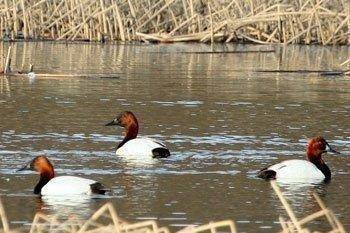Blair Stringham has some great news to share about this fall’s waterfowl hunt.Utah’s waterfowl hunt starts Oct. 6. Your seven duck limit can include one canvasback.
“All of our waterfowl management areas are loaded with ducks right now,” says Stringham, migratory game bird coordinator for the Division of Wildlife Resources, “especially pintails.”
Stringham says about 30 percent of the ducks biologists are seeing on the WMAs are pintails. Pintails are highly prized among many Utah hunters.
“We’re also seeing lots of gadwall and teal,” he says. Stringham says hunters should expect a good opener this year. “There’s lots of ducks out there right now.”
Canada goose populations are also doing well. And plenty of tundra swans will migrate through Utah this fall.
Utah’s waterfowl hunt, which runs for 106 days, starts Oct. 6.
Even though it’s been extremely dry in Utah this year, a wet year in 2011 has helped this year’s waterfowl hunt. “Most of our waterfowl management areas have had plenty of water on them throughout the year,” Stringham says. “The vegetation is doing really well. The marshes are in great shape.”
You can learn more about the marsh conditions, see new maps that will show you where to access the WMAs and learn more about the current number of birds on our website.
Outside of the WMAs, Stringham says water levels are lower.
“The Great Salt Lake is a lot lower than it was last year,” Stringham says. “That includes the Willard Spur, a large freshwater area that’s important to waterfowl. The water level is also low at the Bear River Migratory Bird Refuge west of Brigham City.”
Stringham says both the refuge and the Willard Spur are holding ducks. And the water level at both areas will rise when the irrigation season ends. But because the areas were dry this summer, less food might be available for the birds this fall.
Both the refuge and the Willard Spur are important areas for tundra swans. The birds use the areas to rest and refuel during their fall migration.
“Thousands of swans will migrate through Utah this fall,” he says, “but I’m not sure they’ll stay in Utah as long as they usually do.”
You can get updated water conditions for the Bear River Refuge online.
Stringham provides tips to help you have a successful and enjoyable time hunting ducks this fall:
Scout before the hunt-
Stringham says before Oct. 6, you should visit the WMA you’re going to hunt.В “Take a look at the habitat and the areas on the WMAs the birds are using the most,” he says. “If you scout ahead of time, you’ll know exactly where you want to go on the opener.”
Use decoys-
Hunting over duck decoys is one of the best ways to bring birds in for a good shot. “And remember that you don’t have to use a duck call to bring birds in,” he says. “If you set your decoys out and then hide well, plenty of birds will come into your spread, whether you use a call or not.”
Make sure the birds can’t see you-
Make sure you blend into your surroundings. And try not to move as birds work your decoys or fly overhead. “If you wear camouflage and don’t move much,” he says, “the birds won’t even know you’re there.”
Bring waders and mosquito repellent-
Invest in a good pair of chest waders. “Don’t rely on hip boots to keep you dry,” Stringham says. “Wear chest waders instead. With waders on, you can also retrieve birds that fall into water that’s over your waist.”В Using insect repellent is also important. “There are lots of mosquitoes in the marsh right now,” he says. “Make sure you bring plenty of mosquito spray.”
Get your HIP number and a duck stamp-
Before you head into the marsh on Oct. 6, make sure you have a Migratory Game Bird Harvest Information Program (HIP) number for this season. It only takes about 10 minutes to register in the program, but you must have a hunting license to register.
You can obtain your HIP number at www.uthip.com or by calling 1-877-882-4744.
In addition to your license and HIP number, if you’re 16 years of age or older, you must buy a federal duck stamp. You can get a duck stamp at your local post office. You can also obtain a stamp by calling 1-800-782-6724.
For more information, call the nearest Division of Wildlife Resources office or the DWR’s Salt Lake City office at 801-538-4700.
В

